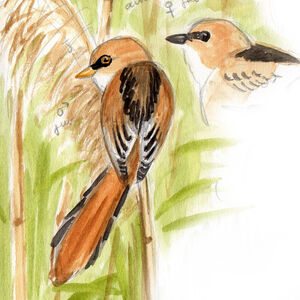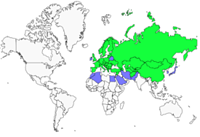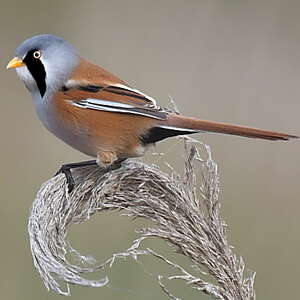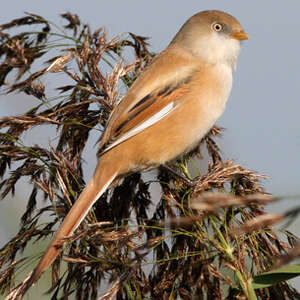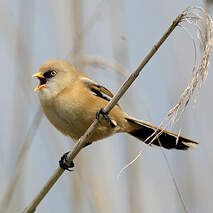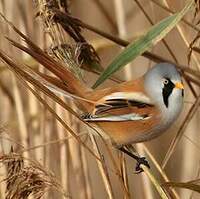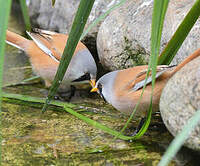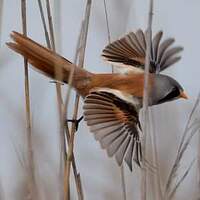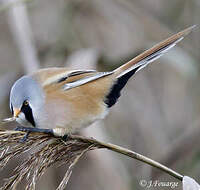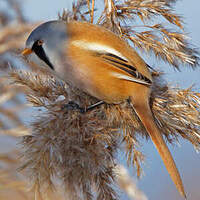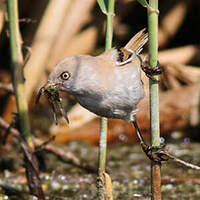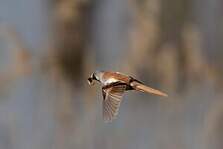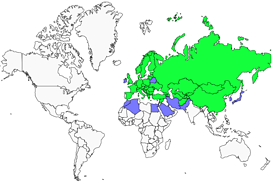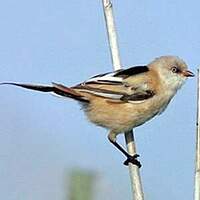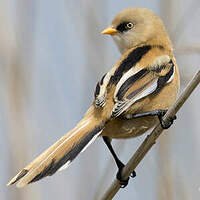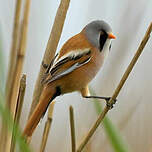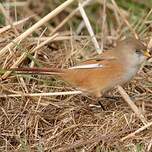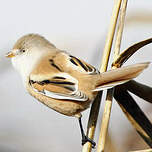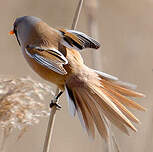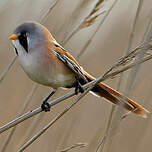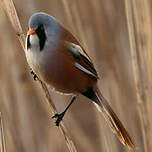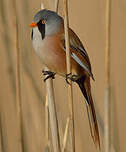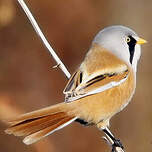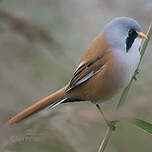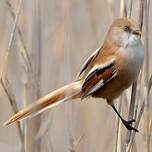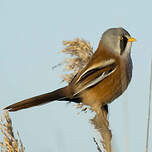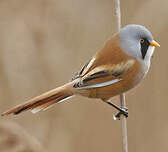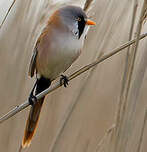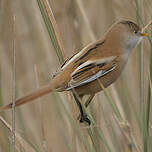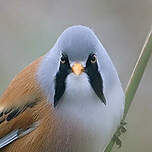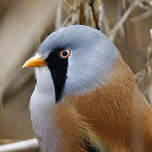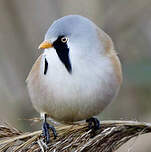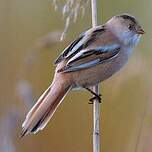Bearded Reedling
Panurus biarmicus - Panure à moustaches
Identification
The Bearded Reedling was formerly called the Mustached Tit but it is not a true tit far from it. It is a bird about the size of the Coal Tit, with a long, undulating tail, a bit like the Long-tailed Tit but larger.
The male, in his nuptial plumage, presents himself as a very rufous bird with a light grey head, which bears two very visible long black "mustaches" that start from the lores. These mustaches have nothing to do with the real mustaches that start from the beak, hence the quotation marks. They are all the more impressive since they are not smoothed down and are clearly distinguished from the underlying contour feathers. The throat is white, the beak and iris are orange. The top of the body, as well as the tail and flanks are very rufous. The external scapulars are white and the white edging of the primary flight feathers create two white bars on the side. The coverts, apart from the great outer coverts which are rufous, and the tertiaries are black with rufous edging. The secondary flight feathers are largely edged with rufous. The chest shows a wine colored gradient with the pale rufous belly. The under tail coverts are black. The leg feathers are black as well.
The female is distinguished from the male by her duller and less contrasted plumage, and above all by her brown head without "mustaches". The under tail coverts are fawn.
The juvenile resembles the female, but its plumage is more contrasted. Light fawn replaces the rufous and black appears, for instance, a black band in the middle of the mantle and back. The outer rectrices show a lot of black. The juveniles can be sexed. The young male has black lores and a yellow beak whereas the young female has lores that are a bit grey and a dark beak.
Subspecific information 3 subspecies
- Panurus biarmicus biarmicus (w, c and s Europe to sw Russia, the Balkans and w Turkey)
- Panurus biarmicus kosswigi (sc Turkey)
- Panurus biarmicus russicus (ec and e Europe through s Russia to ne China, Mongolia, Kazakhstan and c Turkey)
Foreign names
- Panure à moustaches,
- Bigotudo,
- chapim-de-bigodes,
- Bartmeise,
- barkóscinege,
- Baardman,
- Basettino,
- skäggmes,
- Skjeggmeis,
- fúzatka trstinová,
- sýkořice vousatá,
- Skægmejse,
- viiksitimali,
- mallerenga de bigotis,
- Kampameisa,
- wąsatka,
- bārdas zīlīte,
- brkata sinica,
- Усатая синица,
- ヒゲガラ,
- 文须雀,
- 文鬚雀,
Voice song and cries
The Bearded Reedling typically makes two very distinct calls, often alternating between them, that are easily recognizable. The two calls are a tjiup and a sharp tip, often repeated. The tone is fairly low. These are contact calls between members of the same flock, particularly when they are moving around the reedbed or between flocks. The alarm call is a loud piur.
Their song, if it can be called that, is very simple. A short phrase such as tjit tit djuuuunnr that could be mistaken for a rather rudimentary Reed Bunting song.
Habitat
The Bearded Reedling spends almost its whole life in vast and thick reeds beds. It practically never leaves this environment and leads a very hidden and discreet life. Without its loud and characteristic cries, it would go unnoticed.
It is a lively bird that skillfully climbs the reed stalks, slips between them, goes down to the ground and climbs back up. With its skill to move around in thick vegetation, it resembles another inhabitant of the reeds bed, the Reed Bunting.
Behaviour character trait
When winter comes, families who have remained isolated gather in large flocks of up to 40 or 50 individuals. But for the rest of the year, birds live in small family groups. Its status as a sedentary species makes Bearded Reedling populations very vulnerable to severe winter episodes. Populations in the northern part of its range are partially migratory.
Flight
Dietfeeding habits
In the summer, the Bearded Reedling is predominantly insectivorous, feeding mostly on invertebrates. It forages in reedbeds, as well as on the ground or on the surface of the water.
It captures all sorts of insects and their larvae, including aquatic insects, mayflies, caddisflies, etc., and feeds them to its young. Spiders and small molluscs are also part of its diet.In the winter, like true tits, it switches to a granivorous diet. It can consume a wide variety of seeds, from Poaceae, Juncaceae, Cyperaceae, and also dicotyledones outside of the reedbeds where there is no danger. It has no need to worry about not having enough to eat since it has access to a true pantry, the panicules of Phragmites and their numerous seeds.
Reproduction nesting
The Bearded Reedling species is monogamous. Its breeding season is broad and extends practically from March to the end of summer in Europe, allowing at least two successive broods.
The couple builds a nest in a low (5-70 cm) reedbed above water or mud (higher above water) made of reed leaves and other aquatic plants held together with fibers from Phragmites inflorescences. The lining is composed of feathers and sometimes hair. The 5 to 7 white eggs finely speckled with brown are incubated by both adults for 12 or 13 days. Afterwards, they feed the chicks in the nest for 10 to 13 days, then give them another two weeks of care outside the nest. At the end of May or beginning of June, the pair begins a second nesting cycle.
Geographic range
The Bearded Reedling is present throughout the Eurasian continent, from the tip of Brittany to the Amur region in Eastern Russia, including the Black Sea and the Caspian Sea. Its very specific habitat, the reedbed, locally determines its presence. The species is mainly sedentary, but some birds migrate a bit further south, for example to the Mediterranean coast. It is absent from tropical latitudes.
Threats - protection
IUCN conservation status
concern
in the Wild
threatened
evaluated
The species is common in its habitat and has a wide distribution range. Thus, it is not considered threatened at the species level.
It is difficult to determine the overall trend, as some populations are increasing while others decreasing. They are evidently prone to significant fluctuations due to its particular sensitivity to extreme cold winters.
The threats mainly stem from habitat loss. In certain regions such as Turkey, it is thought that the reproducing population is decreasing due to the drainage of marshes. In the Netherlands it is due to reed cutting. Locally, there may still be reed burning around fishing ponds. (info from BirdLife International)
Sources of information
- IOC World Bird List (v13.2), Gill, F and D Donsker (Eds). 2023.
- Les passereaux d'Europe, tome 1, P. Géroudet, M. Cuisin
- Les passereaux d'Europe, tome 2, P. Géroudet, M. Cuisin
- Avibase, Lepage Denis
- Birds of the World, The Cornell Lab of Ornithology
- BirdLife International, BirdLife International
- xeno-canto, Sharing bird sounds from around the world,
Other sources of interest
 Specification sheet created on
24/07/2023 by Jean François
Specification sheet created on
24/07/2023 by Jean FrançoisTranslation by AI Oiseaux.net
published: 18-01-2021 - Updated: 03-02-2021
© 1996-2024 Oiseaux.net
- Accipitriformes
- Aegotheliformes
- Anseriformes
- Apodiformes
- Apterygiformes
- Bucerotiformes
- Caprimulgiformes
- Cariamiformes
- Casuariiformes
- Charadriiformes
- Ciconiiformes
- Coliiformes
- Columbiformes
- Coraciiformes
- Cuculiformes
- Eurypygiformes
- Falconiformes
- Galliformes
- Gaviiformes
- Gruiformes
- Leptosomiformes
- Mesitornithiformes
- Musophagiformes
- Nyctibiiformes
- Opisthocomiformes
- Otidiformes
- Passeriformes
- Pelecaniformes
- Phaethontiformes
- Phoenicopteriformes
- Piciformes
- Podargiformes
- Podicipediformes
- Procellariiformes
- Psittaciformes
- Pterocliformes
- Rheiformes
- Sphenisciformes
- Steatornithiformes
- Strigiformes
- Struthioniformes
- Suliformes
- Tinamiformes
- Trogoniformes

